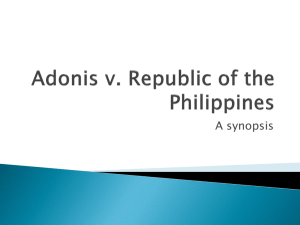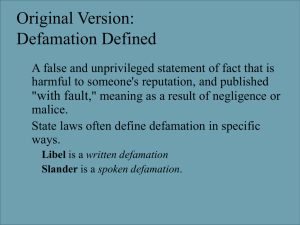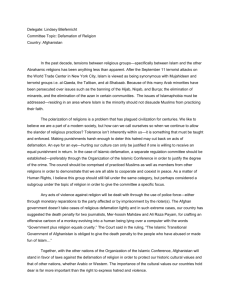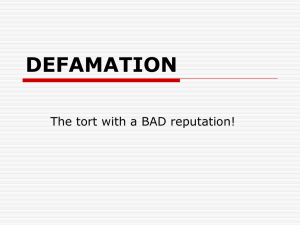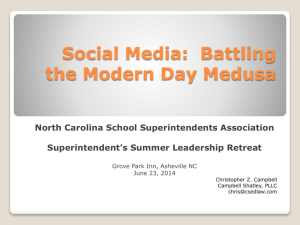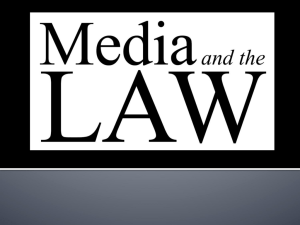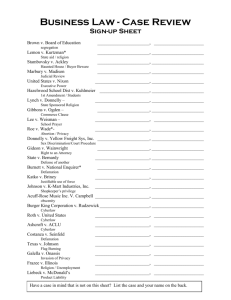Presentation slides
advertisement
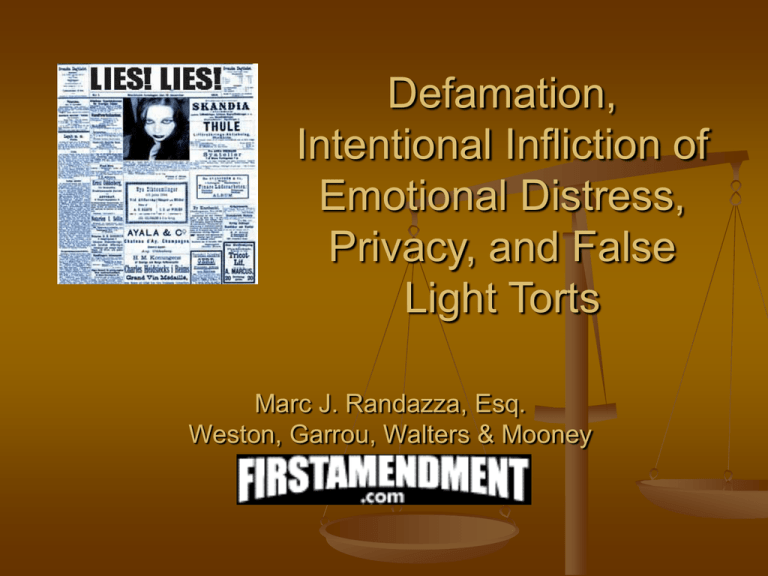
Defamation, Intentional Infliction of Emotional Distress, Privacy, and False Light Torts Marc J. Randazza, Esq. Weston, Garrou, Walters & Mooney Defamation - Generally Defamation is expression that: – Tends to damage a person’s standing in the community. – Through words that attack an individual’s character or abilities. – Damage to reputation. Defamation – Generally (cont’d) Libel = printed defamation Slander = spoken defamation Defamation – Historically The Zenger trial - 1734 – John Peter Zenger was the publisher of The New York Weekly Journal. – Zenger published articles critical of the governor of the colony. – Governor sued Zenger for “seditious libel.” – Claimed the paper would “inflam[e] their minds with contempt of His Majesty's government, and greatly disturbing the peace thereof" Defamation – Historically Seditious libel was a crime of speaking out against the government. It was a strict liability crime & jury was charged with the simple task of determining whether Zenger published the complained of statements. Zenger argued that the statements could not be libelous if they were true. Defamation – Historically English law at the time did not recognize truth as a defense. Libel law was primarily used to protect the government from criticism. The jury refused to enter a guilty verdict. Established the core of U.S. defamation law: Truth is an absolute defense. Laid the cornerstone for the freedom of the press. Defamation Now Libel = printed defamation Slander = spoken defamation Modern Defamation Elements 1. Defamation – there was defamatory language. 2. Identification – the defamation was about the plaintiff. 3. Publication – the defamation was disseminated. 4. Fault – the defamation was published as a result of recklessness or negligence. 5. Falsity – that the statement was false. 6. Damages (unless it is per se defamatory). Defamation The Restatement of Torts says that defamation consists of statements that tend to expose a person to: – Hatred – Ridicule – Contempt Judge determines whether message is capable of a defamatory meaning. Jury decides whether its everyday meaning makes it defamatory. Defamation Key defamation topics – – – – – – – Suggesting P is involved in crime Serious moral failings Incompetence in business or professional life Unpatriotic Mentally incompetent Alcoholic Infected with a “loathsome disease” Businesses, products, and individuals can be defamed (theoretically) Defamation Single instance rule: – Language charging a person with ignorance or error on a single occasion is not defamatory without proof of loss. Saying a referee made a bad call is one thing. Saying a referee was an idiot. Saying that a referee is on the take… Defamation Other topics of defamation suits – Implying that someone is a prostitute (unless they are) – Inaccurate reports of someone having an STD – Not “regular” illnesses. – Calling someone a traitor or a spy. Defamation - Identification Defamatory Characters Real people who provide basis for unflattering characters in works of fiction. May sue for libel If author fails to disguise them. E.g. Real person and fictional person have the same name. Defamation - Identification Geisler v. Petrocelli, 6 Media L. Rep. 1023 (1980). Book called Match Set Main character was a transsexual who helped fix tennis tournaments and had tons of weird sex. Name of Character, Melanie Geisler. Ooops – there was a real Melanie Geisler, who kind of fit the description of the fictional MG. “her body… firm and compact, though heavier than she would like.” Geisler had more proof to offer though – that someone made the connection, or would. Defamation - Identification Smith v. Stewart case Red Hat Club Character “based on” Vicki Stewart She is a drunk and sexually “liberated” GA Court of Appeals held that she was sufficiently identified Defamation - Identification Misidentification See Bell v. Associated Press, 584 F.Supp. 128 (D.D.C. 1984) (756) Impostor says he is Theo Bell, a member of the Pittsburgh Steelers. Newspaper republishes the police report. Defamatory? Defamation False Statement of FACT The statement must be one of fact. Not opinion Who decides that? The Court Decides. No bright line test Court reviews from perspective of an ordinary reader. False Statement of FACT Fortson v. Colangelo & NY Post, 434 F.Supp.2d 1369(S.D. Fla. 2006) Danny Fortson (Dallas Mavs) pushed Zarko Cabarkapa (Phx. Suns) while defending. Zarko falls and breaks his wrist. Jerry Colangelo is owner of Phx suns. NY Post and Columnist Vescey gave Fortson a hard time in public. False Statement of FACT Fortson v. Colangelo & NY Post, 434 F.Supp.2d 1369(S.D. Fla. 2006) Colangelo stated, of Fortson: “He’s a thug. He always has been and is.” He shoud be put down for every day Cabarkapa is out” Vecsey wrote: Fortson should be suspended. He Mugged Cabarkapa Fortson is a “meaningless mass” False Statement of FACT Fortson v. Colangelo & NY Post, 434 F.Supp.2d 1369(S.D. Fla. 2006) Rhetorical Hyperbole Pure opinion Neither is actionable Loose, figurative, or hyperbolic language cannot be reasonably interpreted as stating actual facts about their target. Injury The defamatory statement must actually injure the plaintiff’s reputation. What effect will statement have on an average and ordinary reader? Defamation – Group Libel The smaller the group, the more likely that identification will stick. All of the NFL Players are on Steroids All of the Oakland Raiders are on Steroids. not sufficiently small to warrant libel. Possibly. The entire starting secondary for the Raiders is on Steroids. Yes, sufficiently small for a group libel action. Defaming Public Figures New York Times v. Sullivan 376 U.S. 254 (1964) VERY IMPORTANT CASE Even if the content is false and defamatory, A public official loses Unless they can establish: Knowing falsity, or Reckless disregard for the truth This is the “Actual Malice” standard. New York Times v. Sullivan NYT ran an ad called “heed their rising voices.” Ad sought support for the Civil Rights Movement. Ad contained several false statements. Libel suits were frequent tools in the fight against the civil rights movement. New York Times v. Sullivan Ad falsely claimed: Dining hall at Alabama state college was padlocked by police. There was an attempt to starve students into submission. Police ringed the campus. MLK was not arrested 7 times (it was only 4). MLK was not assaulted (conflicting stories) New York Times v. Sullivan Montgomery, Ala. Police commissioner, LB Sullivan demanded a retraction. NYT refused. Sullivan and Alabama Governor sued NYT for defamation. Sullivan supervised the police so it defamed him. Alabama law was still stuck back in the Zenger days of strict liability. Sullivan was awarded $500,000 by an Alabama Jury. New York Times v. Sullivan US Supreme Court reversed 9-0. Brennan: There is “a profound national commitment to the principle that debate on public issues should be uninhibited, robust, and wide-open, and that it may well include vehement, caustic, and sometimes unpleasantly sharp attacks on government and public officials.” First Amendment needs “breathing room” Public Figures Supreme court built on Sullivan. Expanded actual malice test to public figures as well as public officials. – Curtis Publishing Co. v. Butts – Athletic director at the Univ. of Georgia was a public figure. Curtis Pub. Co. v. Butts, 388 U.S. 130 (U.S. 1967) News article entitled "The Story of a College Football Fix" Prefaced by a note from the editors stating: – "Not since the Chicago White Sox threw the 1919 World Series has there been a sports story as shocking as this one. . . . Before the University of Georgia played the University of Alabama . . . Wally Butts . . . gave [to its coach] . . . Georgia's plays, defensive patterns, all the significant secrets Georgia's football team possessed." Curtis Pub. Co. v. Butts, 388 U.S. 130 (U.S. 1967) Article said that Burnett accidentally overheard a telephone conversation between Butts and the head coach of the University of Alabama, Paul Bryant, Approximately one week prior to the game. Said "Butts outlined Georgia's offensive plays . . . and told . . . how Georgia planned to defend . . . . Butts mentioned both players and plays by name." The readers were told that Burnett made notes of the conversation, and specific examples of the divulged secrets were set out. Curtis Pub. Co. v. Butts, 388 U.S. 130 (U.S. 1967) "the Georgia players, their moves analyzed and forecast like those of rats in a maze, took a frightful physical beating," Article said that the players, and other sideline observers, were aware that Alabama was privy to Georgia's secrets. It set out the series of events commencing with Burnett's later presentation of his notes to the Georgia head coach, Johnny Griffith, Butts resigned from the University's athletic affairs, for health and business reasons. Curtis Pub. Co. v. Butts, 388 U.S. 130 (U.S. 1967) The article's conclusion made clear its expected impact: "The chances are that Wally Butts will never help any football team again. . . . The investigation by university and Southeastern Conference officials is continuing; motion pictures of other games are being scrutinized; where it will end no one so far can say. But careers will be ruined, that is sure." Curtis Pub. Co. v. Butts, 388 U.S. 130 (U.S. 1967) In a defamation case, a "public figure" will need to show: – Damage due to – highly unreasonable conduct – constituting an extreme departure from the standards of investigation and reporting ordinarily adhered to by responsible publishers. Curtis Pub. Co. v. Butts, 388 U.S. 130 (U.S. 1967) Who = Butts? Clearly – Steve Spurrier – Randy Moss – Alex Rodriguez – Tiger Woods Curtis Pub. Co. v. Butts, 388 U.S. 130 (U.S. 1967) Who = Butts? Not so clearly – Minor players – Practice Squad Players – Coaches at smaller schools. Limited Purpose Public Figures Someone who injects themselves into a public controversy to affect its outcome (See Gertz v. Welch). They have to prove actual malice only for defamation directly connected to their voluntary acts. They remain private persons for libelous statements about their private lives. You can be a “nobody” and still be a public figure. Limited Purpose P.F. Alleged defamation involves a public controversy. Person suing for libel has voluntarily joined the fray. Person suing for libel has tried to affect the outcome of the controversy. You can regain your private status after a long time lapse. Used To Be A Public Figure Time can transform a public figure into a private one. Case by case basis. An athlete may pass into memory, but if he is involved in newsworthy events and matters of public interest – the PF status may never go away in that context. Defamation – Florida’s Elements In order to sustain a cause of action for defamation in Florida, the Plaintiff must allege false statements of fact, published to a third person, which caused damage to the Plaintiff. Without those essential elements, there is no libel. See, e.g., Valencia v. Citibank, 728 So.2d 300 (Fla.3d DCA 1999). See also Cape Publications, Inc. v. Reakes, 840 So.2d 277, 279-80 (Fla. 5th DCA 2003); Linafelt v. Beverly Enterprieses-Florida, Inc., 745 So.2d 386, 388 (Fla. 1st DCA 1999); Smith v. Cuban Am. Nat’l Found., 731 So.2d 702, 705 (Fla. 3rd DCA 1999)). Defamation – Florida’s Elements ISOLATED FALSEHOODS – Even if there are isolated false facts, “substantial truth doctrine” isolated and cherry-picked errors or falsehoods will not sustain a cause of action for defamation. Smith v. Cuban American Nat’l Foundation, 731 So.2d 702, 706 (Fla. 3d DCA 1999) (“Under the substantial truth doctrine, a statement does not have to be perfectly accurate if the ‘gist’ or the ‘sting’ of the statement is true.”). Florida Elements A statement is not considered to be a defamatory falsehood unless it ‘would have a different effect on the mind of the reader from that which the pleaded truth would have produced.’ Woodard v. Sunbeam Television Corp., 616 So.2d 501, 503 (Fla. 3d DCA 1993); Early v. Palm Beach Newspapers, Inc., 354 So.2d 351, 352 (Fla. 1977); Bishop v. Wometco Enters., Inc., 235 So.2d 759 (Fla. 3d DCA 1970); Hill v. Lakeland Ledger Publ’g Corp., 231 So.2d 254, 256 (Fla. 2d DCA 1970); Hammond v. Times Publ’g Co., 162 So.2d 681, 682 (Fla. 2d DCA 1964); McCormick v. Miami Herald Publishing Co., 139 So.2d at 197, 200 (Fla. 2d DCA 1962). Cautionary Tale – Murphy v. Boston Herald Boston Herald covers story about a rape case 14 year old victim Murphy v. Boston Herald Herald reports Judge says “she can’t go through life as a victim, tell her to get over it” National media frenzy Murphy v. Boston Herald Judge comes under major attack Judge sues Must overcome actual malice standard Murphy v. Boston Herald Murphy claims that he said that she needed counseling to help her cope with the crime Needed help to get over it Clashing stories Murphy v. Boston Herald Why did Herald lose? Herald reported based on an interview with a prosecutor Prosecutor is a member of the Bar and a state official Reporter said he trusted him But Reporter had thrown away his notes! Murphy v. Boston Herald 1. 2. 3. If a story seems to be scathing, ask a few sources about it. If someone has a contradictory version of the facts, at least mention it. Have a policy for when you discard your notes. The longer the time period, the better. But, when a reporter is called to a deposition, he should be able to say “I destroyed my notes on this day, as is consistent with my policy.” Don’t let your lawyers talk you into skipping the intermediate appellate court. If you do that, the only option you have is to petition the Supreme Court – good luck with that. Veranda Partners v. Giles Infliction of Emotional Distress Hustler v. Falwell, 485 U.S. 46 (1988). The People v. Larry Flynt case. Underlying case was a libel case But jury held that nobody would think it was true, therefore not defamatory. IED case survived though. Hustler v. Falwell Hustler published this ad. Discusses Jerry Falwell having sex with his mom in an outhouse. Hustler v. Falwell Falwell: My first time was in an outhouse outside Lynchburg, Virginia Interviewer: Wasn’t it a little cramped? Falwell: Not after I kicked the goat out. Interviewer: I see. You must tell me all about it. Falwell: I never really expected to make it with Mom, but then after she showed all the other guys in town such a good time, I figured, "What the hell!" Interviewer: But your Mom? Isn’t that a little odd? Falwell: I don’t think so. Looks don’t mean that much to me in a woman. Interviewer: Go on. Falwell: Well, we were drunk off our God-fearing asses on Campari, ginger ale and soda—that’s called a Fire and Brimstone—at the time. And Mom looked better than a Baptist whore with a $100 donation Interviewer: Campari in the crapper with Mom. how interesting.. .Well how was it? Falwell: The Campari was great but mom passed out before I could come. Interviewer: Did you ever try it again? Falwell: Sure. Lots of times. But not in the outhouse. Between Mom and the shit, the flies were too much to bear. Interviewer: We meant the Campari. Falwell: Oh, yeah, I always get sloshed before I go to the pulpit. You don’t think I could lay down all that bullshit sober do you? Hustler v. Falwell The sort of robust political debate encouraged by the First Amendment is bound to produce speech that is critical of those who hold public office or those public figures who are "intimately involved in the resolution of important public questions or, by reason of their fame, shape events in areas of concern to society at large. … one of the prerogatives of American citizenship is the right to criticize public men and measures. Such criticism, inevitably, will not always be reasoned or moderate; public figures as well as public officials will be subject to vehement, caustic, and sometimes unpleasantly sharp attacks. The candidate who vaunts his spotless record and sterling integrity cannot convincingly cry 'Foul!' when an opponent or an industrious reporter attempts to demonstrate the contrary. Internal citations and quotes omitted Toffoloni v. Hustler (Nancy Benoit case) For More Information I keep a blog on media law and First Amendment matters: The Legal Satyricon (www.randazza.com) Or use the contact information below ____________________________ Marc John Randazza Attorney at Law Weston, Garrou, Walters & Mooney 781 Douglas Avenue Altamonte Springs, Florida 32714 Tel: (407) 975-9150 Fax: (407) 774-6151 Mobile: (407) 739-7887 E-mail: mrandazza@firstamendment.com Dedicated to the Defense of Freedom And the Protection of Creative Expression ________________________________
